Iacobucci and Rayburn (right) plan to fly the world
Or how a pair of multi-millionaire tech heads, some lateral P2P thinking and a truck load of technology may well revolutionize the air transportation industry.
[Edit 08/11/2023: 18 years on, and it seems as though the dream still lives on, despite the tragic passing of Ed Iacobucci several years ago. From what I can tell, Ed’s wife is now at the helm of affairs, and the project continues under the AtlantisRoad Corporation banner, out of Florida. No news on actual flights though, alas!]
If jovial entrepreneur Ed Iacobucci has his way, within a few years the face of aviation around the world could be changed for ever. Gone will be the heartache and horrors of current airport travel, the cattle truck mentality and terrorist playing field, replaced by a sophisticated on-demand, fly anywhere air service more like a limousine experience than an airline. His new venture, Dayjet, is a bold step into the unknown and one which may well point to the direction of future transportation in general.
The driver behind this 21st century revolution is, as might be expected, the awesome power of information technology, but in this case harnessed in totally innovative ways to transform the way we buy, use and experience air travel. The story starts at an annual Agenda conference in Scottsdale, Arizona in 2001. Self confessed technology junkie Iacobucci was hanging time after having departed Citrix Corporation, the ultra successful networking company he founded in 1989, a retirement that didn’t sit easily on the affable Georgia Tech engineer’s head.
“My retirement lasted precisely three months,” he told The Ferret in an exclusive interview on the eve of the airline’s official launch, “Then I realized that I wanted to do something else with my time.”
The main speaker at Agenda was ex-Microsoft executive Vern Rayburn, talking about his new found passion for small jet aircraft – usually called VLJs or Very Light Jets. He had just set up a new company called Eclipse Aviation to manufacture these small commuter planes and fill what he felt was a gap in the aviation market. When Iacobucci heard Rayburn describe his vision of the future it was like a light bulb going off.
“I wasn’t too excited about his idea that professionals would buy and fly their own jets,” Iacobucci explains, “But his concept of creating the Model T of aircraft, cheaply and through mass production technologies really struck a chord. It was a bold and interesting vision.”
The reason was simple. The year before Ed and his wife Nancy had set up their own air limousine charter company, small but very up market, hiring out Lear jet quality aircraft to companies and net high worth customers to provide the kind of transport they needed in a busy working schedule. But Iacobucci felt that there was something missing. Wingedfoot Services had a stellar reputation, a diamond crusted clientele and a solid position in the market, but it worried him that these sorts of services were only supplied to a very small and elite customer base.
“The idea of moulding travel around your schedules instead of the other way around is extremely addictive and almost life changing. But it just didn’t seem right that it should only be available for a privileged few.”
He’d been toying with the idea of extending the market, but was getting nowhere fast. They just couldn’t work out a way to make the charter price attractive enough and still make money using their fleet of traditional multi-million dollar aircraft. Which is where Eclipse came in.
The two entrepreneurs flew back to New Mexico after Agenda finished and started talking about working together on a true ‘on demand’ air service. The big constraint that Iacobucci had identified early on was that of operational logistics. It wasn’t simply a matter of building cheaper planes and cutting costs. Without state of the art systems in place for things like maintenance and scheduling, no service like this could survive or, more importantly, scale.
“The problem isn’t about the aircraft, it’s about the underlying business model,” says Iacobucci, “The optimization of systems, the scheduling, operations and every other aspect of providing a large scale air service at low cost.”
A few months later in January 2002 he launched Jetson Systems, having put together a crack team of multi-disciplinary experts who, instead of concentrating on conventional aviation issues, were tasked with building an entirely new paradigm, one in which the only carry over from the traditional airline model would be safety and security issues. “We kept ourselves aligned with Rule 135 [federal regulations on non-scheduled airline services] and literally threw everything else out of the window to start afresh.”
The company’s launch announcement on April 25th 2005, with a new name, logo and tagline (DayJet Corporation: ‘It’s about time’) is the culmination of this three year project to change the way we fly. It is a bold gamble, and one which relies on a massive amount of technology, knowledge management and sheer number crunching dexterity. To understand it properly, one needs to dig beneath the press releases and look at the super-scaffolding which is bringing it all together. The hardware, software and systems which will power the first per seat, on-demand air transport service in the world.
The system centre.
“Our vision is deceptively simple – that on-demand air transport between secondary markets is a commercial reality for both consumers and operators,” says Iacobucci, “Some people say that this exists now, but I’d argue otherwise, because the services that currently operate are high end, and very costly to run.”
His idea was indeed simple. Before embarking on the process of setting up the conventional aspects of an airline; crew, ticketing, operations et al, he would do something that had never been done before. He would create a completely virtual business. Instead of hiring the usual management and operational teams, he took some of the $18 million of first round funding and bought himself a posse of geeks – mathematicians, demographers and complexity scientists he calls ‘ant farmers’, threw in a room full of computing power and modelled the airline in detail. Excruciating detail.
“We’ve spent the last two years testing out our market model using agent based modelling, a kind of glorified Sim City, if you will,” he explains, “It’s a technology widely used by governments and transportation agencies to model cities, but we used it to see what would and could happen in terms of travel between geographic locations. We wanted to predict the collective behaviour of business traveller communities in detail.”
This meant breaking the US down into 10×10 mile squares, while extrapolating rich demographic statistics like incomes, IRS data and the effects of marketing on travel preferences. The boffins then looked in detail at nine different classes of regular travellers from the $70,000 to $300,000 a year business executive, loaded up price and time schedules for trains and buses, as well as gas prices and driving costs at various times of the day, in fact every variable that could be added to create an elaborate model of business travel in the USA. The programs were run, tweaked and re-run again and again until these virtual travellers behaved on the computer simulation almost exactly as real travellers had actually done the year before, as taken from hard factual data the team had to hand. Once the model was tested and tuned, they could then model future scenarios, adding in the proposed Dayjet on-demand service as a live new factor.
This painstaking iterative process eventually let them accurately model 10 quarters of operation of an airline which didn’t yet exist, even down to the minutiae of managing reject rates through fare manipulation. At the same time other members of the team went out and held face to face focus groups with small and medium sized companies, executives and agencies in nine cities to pull together qualitative data to add to the mix. What’s more astonishing is that this whole two year project was not completed using massive mainframe computing power, but instead relied on twenty dual processor 3GHz Pentium personal computers hooked together in a cluster. This computer system will also be the backbone of the airline once it starts operating in earnest next year.
“We aim to continue modelling the service constantly as we go into operation,” says Iacobucci, “We’ll react to demand by adding planes and adjusting the availability of destination cities as necessary. What’s fascinating is that almost all of the new market we’re creating seems to come from the car driving traveller. What’s more, not only does our on-demand travel increase, but also scheduled flights, so air travel in general wins and the highways lose.”
This focus on technology doesn’t stop at the pre-launch work. The whole Dayjet concept rests on the shoulders of a totally automated routing and scheduling system, run on PC clusters in a couple of relatively small operation centres. The idea is that everything from the choice of pilot, aircraft and the stopovers necessary to make for the most efficient load/journey times, will be calculated and scheduled by the sophisticated software developed from this early modelling work. The technology is designed to resolve reservation requests within five seconds of the customer making an enquiry.
Iacobucci is coy about actual fare and route information – “we haven’t firmed up on all the details yet” – but is clearly pleased with the fact that the models have vindicated his concept so far. “Our whole service is based on four fundamentals. One, we will run a large fleet of small craft, it’s the granularity of small packet sizes that makes it all feasible. Two, we will only operate within constrained geographic boundaries, a kind of bounded P2P network. Three, it will be a strictly no frills service, no meals, no toilets. Finally it will be totally, 100% automated.”
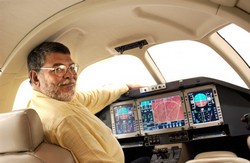
Because it’s an on-demand service there can be no schedules, otherwise the strict FAA Rule 121 regulations apply, so each trip is negotiated individually with the customer at the time of the request. The three main factors that determine the price are – how early are you willing to leave, how tight is your departure window and are you willing to stopover and share your flight? The tighter your time constraints, the more expensive the seat becomes. But even so, prices are expected to be only a little more than a full fare scheduled trip, which is way below the $4000 an hour it usually costs to hire a conventional air limousine. The company is banking on the fact that when the cost of a hotel for an overnight stay is factored into the fare calculation, a Dayjet trip will still turn out cheaper for short regional journeys than driving or taking alternative land transportation.
Dayjet is planning to launch the first customer flight in mid 2006, but before then work is continuing on refining the systems and operational capabilities that will make the whole thing work. The company will select suitable customers in the target regions – personnel from small and medium sized companies with an immediate need for short range flexible travel – and encourage them to sign up to the service launch. They will then be given access to a Web portal or an integrated section on the Dayjet intranet from where they can request flights as necessary.
The company will start services with six planes, ramp up to sixteen by the 2nd quarter of operation, 65 planes by the end of the first year and be running an ambitious total of 300 aircraft within 24 months. The first routes have yet to be decided, but the plan is to select a range of secondary airport destinations in various regions. So, for example, in the twelve states of the Midwest there might be 40 – 50 destinations to choose from.
Iacobucci anticipates that the company will only be looking to secure 2 to 3% of the total traffic of a region, in order to avoid being swamped by demand. So for many impractical journeys there will be no allocation of seats and the customer will have to revert to traditional transport options. While this initially may seem to go against the whole concept of mass market on-demand, reading between the lines, it’s clear that the Dayjet team have lofty ambitions to make this new form of transport as big a revolution in travel as the introduction of the rental car network. They are banking on the fact that the use of this kind of super automated technology will let them grow the business fast enough to meet whatever market demands the future holds.
“Aviation hasn’t really changed much in 100 years, but DayJet will be completely different from the ground up,” Iacobucci explains, “Everything will be digital, from workflow management to databases, everything will be scanned in and utilised in digital form. We’re using embedded technology to build a service which literally could not exist without these sophisticated software systems. If you’re still using a manual system you can’t really scale to more than 120 aircraft in each scheduling class.”
The plane truth.
Another core component of the per seat on demand business plan is having an aircraft which is cheap, robust, flexible and efficient. It must also offer a travel option that customers want. And that’s where the Eclipse 500 aircraft should earn its wings.
“The travelling public don’t want to travel behind propellers, they want to travel in jet aircraft,” confirms Vern Rayburn, CEO of Eclipse Aviation, “We’ve designed a jet with operating costs less than half that of current equivalents, and which is a quarter of the price. It’s also a high utilization aircraft, a six seater [Boeing] 737. Reliable, and easy to fix.”
On the face of it the Eclipse 500 looks just like any other small corporate aircraft – sleek, shiny and expensive. Look closer though, and a number of interesting features begin to stand out. First off are the engines. The twin jets at the rear of the plane are almost toy sized, with an inlet diameter of just 14 inches. The interior also is significantly different. Gone is the closed off cockpit and exorbitant fittings of an executive jet, replaced by an elegant but simple interior that looks more like the inside of a luxury car than a jet aircraft.
The cockpit adds to the surprise, as it lacks traditional dials and gauges and instead is equipped with a bevy of colourful LCD screens and discrete soft switches. Actually the ‘newness’ of this bird is only partly to be found in the fixtures and fittings. The real revolution is buried deep inside the minutiae of manufacturing, design and operational management which powers the development and production of this new class of aircraft.
Fact 1. The Eclipse 500 is not made of trendy but expensive composite fibers as with some alternative VLJ designs, but instead relies on aluminium. The clever trick is that the craft is assembled using a sophisticated welding system called Friction Stir Welding, which reduces the number of seams and crucially does away with the heavy rivets used in traditional aircraft design. Result, a huge weight saving, whilst retaining structural strength and resilience. The 263 welds on the plane replace 7,378 conventional fasteners.
Fact 2. The avionics, from Avidyne, are based on state of the art, software configurable plug-in control panels. The aircraft’s instrumentation can be maintained and upgraded with simple plugin modules which add more functionality as needed. Result, a massive cost saving, meaning in some cases 10 times less on expenditure for cockpit systems.
Fact 3. State of the art Pratt & Whitney Canada engines offer 900 lbs of thrust from an industry leading size and weight configuration. Result, better payload capabilities and range than comparable aircraft of the same size and weight. Result, running costs should be somewhere in the order of $0.69c per mile (at year 2000 values). The aircraft is designed to fly at a height of 20–25,000 feet at 375 knots. Most of the short run, on-demand journeys are likely to be a maximum of 300 to 600 miles in distance.
Fact 4. Design and manufacture. The secret of the sauce is often in the hidden ingredients and so it is with the Eclipse 500. The plane is a complete digital design, no metal models or prototyping. All of the documentation and even the factory layout (down to the placement of stair handrails) is done digitally. Result, unprecedented speed of design, test and prototyping. The company currently holds three design reviews a week, and is on track to meet an eventual, and astonishing, production target of six planes a day.
Fact 5. The backend operational systems are state of the art SAP Netweaver powered. This is a small company which has implemented enough computing power to ensure scalable production into the big league.
Fact 6. The above technological focus has resulted in an aircraft that matches the performance specifications of craft 2 or 3 times its cost. The current price of an Eclipse 500 is set at around $1.3 million, which is unprecedented for a jet aircraft of this specification.
“We have 2200 orders on the books and will start delivery of our first aircraft by March of next year,” says Rayburn, “The whole Dayjet philosophy is a really nice mesh with that of Eclipse. You make sure you set rational price points for this kind of transport, and charge exactly what it’s worth.”
Take me to the pilot.
One of the arguments that is commonly levelled against the growth of mass market regional jet services is the problem of recruiting and managing large squads of pilots at the required level of experience. Twin jet aircraft are an order of magnitude more difficult to fly than prop planes, and the number of qualified pilots who are willing to forsake the lure of more upmarket airline jobs is understandably small. Iacobucci is typically bullish about the problem.
“Technology can help overcome the issues with both pilot retention and scheduling,” he says, “Traditionally pilots are expected to do shift work, three days on, three off. We’ll offer our pilots Monday to Friday morning and afternoon shifts, they’ll fly to local regional airports, and be back home every night. It will provide a whole new quality of life for them and their families.”
The company plans to start off with two pilot crews, and although Iacobucci claims that Dayjet has no immediate plans to change this configuration, it’s clear that these on-demand pioneers hope to offer single pilot services some day if they can work out how to make it safe and efficient.
“We’re doing a lot of research with United Airlines to see how we can move towards single pilot operations,” says Rayburn, “It will take time, but somewhere in the future you will probably see a single person in the cockpit of this type of service.”
Dayjet will also offer positions to more senior pilots in the 60 year age range, who may be looking for more regional work after a scheduled airline career, and the company also plans to open its own flight school university to grow its own pilots and culture. Predictable work hours and equity ownership appear to be two of the features which Dayjet hopes will lure the pilots they need, although there is one factor that Iacobucci says may make it harder for some pilots to join the Dayjet revolution.
“We’re going to be very picky in choosing our pilots, not just because we need the best pilots, but because we also need ones with great personalities. Our whole culture is about getting closer to the customer and we need pilots who can reflect that by being ambassadors for the service in every way. In return we’ll give them the kind of perks that reflect their importance to the operation.”
Ad Astra?
So will the fledgling airline manage to do what no-one before has achieved, and introduce mass market taxi-cab aviation to the world? Will Dayjet turn out to be the Hertz of aviation? There’s no doubt that the launch of the VLJ aircraft concept has radically changed the playing field in terms of what can and cannot be done with small jets in a regional market. Cheaper jets mean cheaper borrowings and overheads, means lower prices.
But of course lower prices mean nothing if you cannot manage demand, and this is where the Dayjet technology powered vision comes into its own. Competitive services on the horizon such as Pogo and Penguin Airlines appear to be treating the new breed of VLJ aircraft as no more than a replacement for older craft, while Iacobucci and Dayjet clearly see the new planes as mere packets in a sort of vast P2P transportation network, to be shuffled around as efficiently as possible. Iacobucci and his team are in effect trying to create a service which satisfies the long tail market for short run air travel; offering new destinations to people who have never considered on-demand air travel simply because it didn’t exist before. It’s clever stuff all right, at least on paper and in the computer simulations.
The real test of course comes with roll out in a real world. A world with volatile oil prices, governments and regulatory bodies. A world where a major crash can ruin a reputation in seconds, and in the case of Dayjet that could mean computer or aircraft. A world where competition is cut-throat and vicious predatory pricing a way of life. The challenges are formidable, and it will be fascinating to see whether a couple of geeks can really take on the world and win; with just some software, a few ant farmers and a vision.
Further reading.
A Jet for the Rest of Us.
Air Taxi at Your Service.
Ready Jet, Go.
The Sun Shines…
Entrepreneurs Set their Sights…
Eclipse Gears up to Train Pilots…
Flight of Fancy…
Continue Reading… 1 2 3 4 5 [View All]

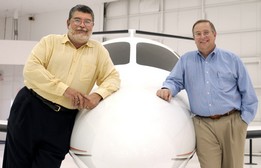
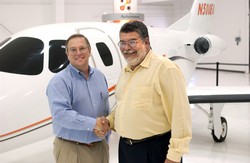
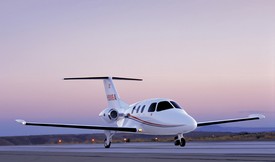
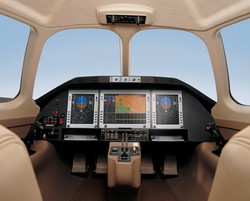
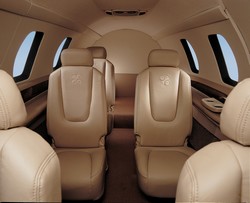



Wow Red, this is exciting, and much more than I expect from a blog. Not to denigrate the Journal, but is this running elsewhere? It seems to deserve more mainstream coverage.
Sounds like flying may be fun again. Soon. Coincidentally I just moved to New Mexico…
Heh, thanks Andi. No I haven’t placed it anywhere else yet, and I agree that I think it could be very interesting in the long run and so deserves more attention. Let’s see, maybe some cute Ferrety reader will pick it up….
I’ll be fascinated to see how the project goes, and hope to have another chat with Ed when he next comes over to Europe. :)